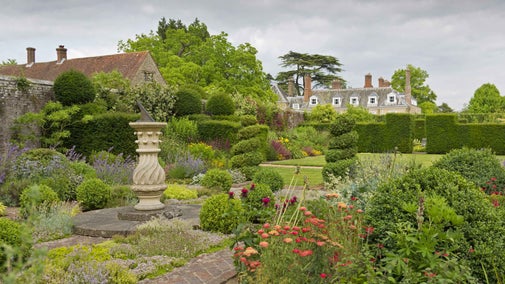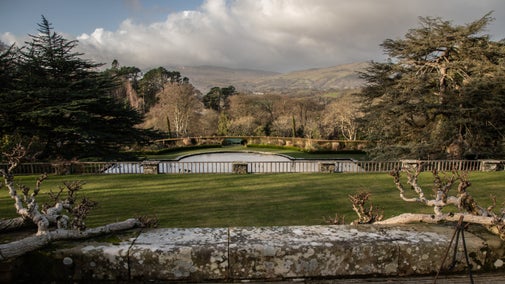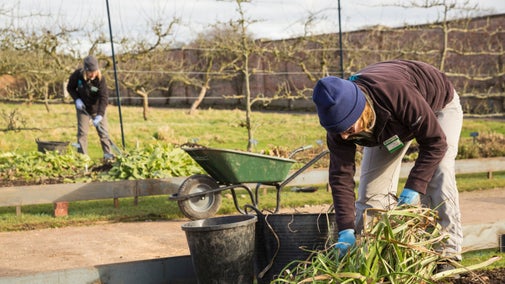
Discover more at Woolbeding Gardens
Find out when Woolbeding Gardens is open, how to get here, the things to see and do and more.

Explore the 26-acre garden and take in the garden rooms, each with a carefully chosen colour theme, from deep reds to pastel pinks. Discover the array of modern planting, set against the formal backdrop of the walled garden, visit the winding paths of the new Silk Route garden, admiring plants from the ancient trading route, or walk across the meadow to discover the Long Walk, a pleasure garden with summer houses, waterfalls and a river-god grotto.
When you arrive, you’ll be welcomed into the entrance garden, which was formerly the old farmyard. This area was completely transformed by Julian and Isabel Bannerman by creating a dry garden with formal water pools surrounded by informal perennials and olive trees.
At the heart of the garden are the west borders. A palette of blue, white and pale yellow, roses, tulips and forget-me-nots line the avenue, perfectly framing the view beyond the gates into the countryside. The walls are full of climbing roses and the borders are bursting with blooms in summer.
Admire the combined textures, tones and shapes of the leaves that make up the four immaculate Euonymus-hedged beds surrounding the Italian well. Here you will find collectors’ items such as Schefflera from Taiwan or Oreopanax from Mexico that share a flower bed with native British species.
This corner of the garden features a sundial at the centre and spiralling topiary balls alongside Falstaff apples trained in diamond shapes up the walls. The beds are filled with lavender, thyme and other edibles.
Hidden within the walls of the formal garden, the fountain is one of the hidden gems at Woolbeding. From here you’ll see that each corner of the garden is laid out in a colour wheel from rich pinks, splashes of blue to sunset oranges, with many flowers for you to enjoy during your visit.
The orangery houses an array of potted citrus in winter and is a perfect place to sit and relax in summer with views over the swimming pool. Designed by Philipp Jebb in the 1970s, the orangery is the centrepiece of the Formal Gardens.
Behind a hidden door you’ll discover the greenhouse, which holds an exotic jungle-like collection of plants and ferns that are kept constantly warm to encourage them to grow all year round.
Traditionally used to grow vegetables for use in the main house, the vegetable garden is home to the ornamental potager made up of around 1,200 lettuces that surround a topiary box swan.

Inspired by the classical landscape gardens and pleasure grounds of the 18th and 19th centuries, the Long Walk at Woolbeding Gardens contrasts with the formal garden rooms around the house.
The Long Walk was designed by Julian and Isabel Bannerman for Simon Sainsbury and Stewart Grimshaw in 2000. It’s a circular route with unexpected follies that draw you around the garden, with every corner bringing something new.
The planting of the Long Walk is more relaxed than the scheme in the garden rooms, with more naturalistic planting, including rhododendrons, Gunnera, hostas, osmunda, various primulas, irises, pulmonarias, philadelphus and hydrangeas.
There are a number of mature specimen trees, including Abies grandis, Taxodium distichum, Sequoia sempervirens, as well as a small grove of Metasequoia glyptostroboides.
In spring there are daffodils and cherry blossom and in summer red valerian, campion, cow parsley and foxgloves flower freely around the ruins.
The ruined window arches, cracked walls and stone pillar bases give the abbey an impression of great age and antiquity. In fact, it’s a folly that was constructed in around the year 2000.
Beautifully hand-crafted, this thatched folly has wands of hazel and pine cones lining the interior, a paddle stone floor and four knobbly elm tree trunks as pillars.
Designed by Philip Jebb, this octagonal gothic pavilion stands at the head of the waterfall. The seats inside have one of the best views in the garden, across the lake and to the surrounding hills.
This is a cool place on a hot day, with the sound of running water from the rill and planting including Sarcoccocca, Erythroniums, hostas, Dryopteris ferns, foxgloves and other shade lovers.
Water bubbles from the top of a 2.5 metre high tufa monolith, catching the light as it pours down to the rill that ultimately feeds the waterfall. Looking on from leafy alcoves are statues of the four seasons.
Sculpted by Tom Verity, Neptune benignly surveys his watery kingdom from the shelter of a rocky alcove surrounded by honeysuckle, Angelica archangelica, Digitalis and Alchemilla mollis. His cloak is made of oyster shells and he rests one arm on an urn gushing water around his feet.
A hide made from locally collected hazel and chestnut is surrounded by woodland. There are bird feeders around the hide so that you can watch the local bird life, including tree creepers and great spotted woodpeckers.

Inspired by a former cedar tree that once stood in the same position, the impressive William Pye water fountain is a four-metre-high sculpture.
Watch how the water is allowed to perfectly spill over the edge of the bowl into the central trunk to resemble a tree shape.
Accessible by a secret door from the garden, the parish church of All Hallows neatly borders the garden. Inside the walls of the Grade I listed church, you’ll see beautiful stained-glass windows and original Saxon features.
The church is still run and maintained by the local parish of Midhurst and is open for visitors in the summer months.
The perfect shelter from any passing showers, here you can take in the views towards the River Rother and surrounding countryside.
Designed by Philip Jebb, this classical temple folly is named after a tulip tree that fell in the winter storms of 1987.
Take the steps down from the Tulip Folly, walk slowly along the tunnel and admire the hornbeam trees, twisting at every turn. This is a historic feature of the garden.
From here, walk along by the River Rother. Here you’ll find meadows of buttercups, daises and yarrow growing wildly into the sweeping landscape.
The National Trust has supported The Woolbeding Charity to construct and open to the public a bespoke new glasshouse and garden, designed by Heatherwick Studio. The striking ten-sided glasshouse and landscaped series of garden zones exhibit plants, shrubs and trees that depict the key regions of the Silk Route.

Find out when Woolbeding Gardens is open, how to get here, the things to see and do and more.
A history of Woolbeding Gardens, a horticultural haven bursting with colourful planting, a contemporary glasshouse and countryside views.

Discover a new 10-sided contemporary glasshouse, surrounded by a garden featuring plants, shrubs and trees that depict the key regions of the Silk Route.

Find out more about bringing your group to this horticultural haven bursting with colourful planting. There’s plenty to see including follies, stunning herbaceous borders, a Chinese bridge and the Gothic Summer House with waterfall.

Why not join the team that looks after Woolbeding Gardens? From getting more exercise in the garden to learning something new, there are plenty of reasons to volunteer with us.

From 18th-century water gardens and Arts and Crafts landscapes to intimate woodland gardens, there are so many places to discover.

Discover our gardeners’ top tips so you can make the most of your garden, plot or window box.

Beautiful gardens are found all over Sussex. The romantic gardens at Nymans and Bateman's; and Capability Brown landscapes at Sheffield Park and Petworth are all yours to explore.
